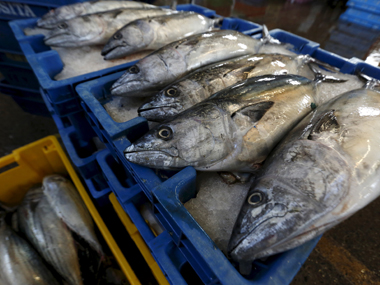Beware of the fish you eat.
The Telegraph Calcutta
reports that more than one-fifth of the seafood sold in markets and restaurants is not what the label says it is. According to the report, scientists that conducted the research found that, “22 of the 100 samples of fresh, frozen, ready-to-cook or ready-to-eat seafood they had collected had been mislabelled.” [caption id=“attachment_2376790” align=“alignleft” width=“380”]
 Reuters[/caption] But that’s not all. Cheaper fish is also being substituted for more expensive fish without the buyer’s knowledge. New varieties, never before consumed, are being detected in fish dishes with increasing regularity. Take seer fish, for example. Scientific testing has proved that it was found to be mackerel, the red snapper fillet was actually catfish, and the pomfret was threadfin silver biddy. “It is unclear whether the mislabelling is intentional or unintentional,” Kannuchamy Nagalakshmi, fisheries scientist at the Central Institute of Fisheries Education, Mumbai, told the newspaper. But this happens all over the world. In Ireland, a
similar study
of samples bought in Dublin restaurants, shops and supermarkets revealed that a quarter of products labelled as cod or haddock were in fact completely different species.
BBC
also reported in 2013 that in the United States, 25% of the fish served in restaurants in New York was not what it was stated to be on the menu. There may, however, be a solution to this. Reuters
reported in February that a pair of scientists from Florida had developed a device they claimed could genetically verify whether imported fish destined for dining tables was actually grouper or a less expensive, and potentially harmful Asian catfish that is often passed off for the popular firm-fleshed species. This could prove to be a good way to get around these growing cases of mistaken identity.
Reuters[/caption] But that’s not all. Cheaper fish is also being substituted for more expensive fish without the buyer’s knowledge. New varieties, never before consumed, are being detected in fish dishes with increasing regularity. Take seer fish, for example. Scientific testing has proved that it was found to be mackerel, the red snapper fillet was actually catfish, and the pomfret was threadfin silver biddy. “It is unclear whether the mislabelling is intentional or unintentional,” Kannuchamy Nagalakshmi, fisheries scientist at the Central Institute of Fisheries Education, Mumbai, told the newspaper. But this happens all over the world. In Ireland, a
similar study
of samples bought in Dublin restaurants, shops and supermarkets revealed that a quarter of products labelled as cod or haddock were in fact completely different species.
BBC
also reported in 2013 that in the United States, 25% of the fish served in restaurants in New York was not what it was stated to be on the menu. There may, however, be a solution to this. Reuters
reported in February that a pair of scientists from Florida had developed a device they claimed could genetically verify whether imported fish destined for dining tables was actually grouper or a less expensive, and potentially harmful Asian catfish that is often passed off for the popular firm-fleshed species. This could prove to be a good way to get around these growing cases of mistaken identity.
Something fishy! One-fifth of the seafood sold in markets is mislabelled
FP Staff
• August 3, 2015, 15:42:32 IST
More than one-fifth of the seafood sold in markets and restaurants is not what the label says it is.
Advertisement
)
End of Article